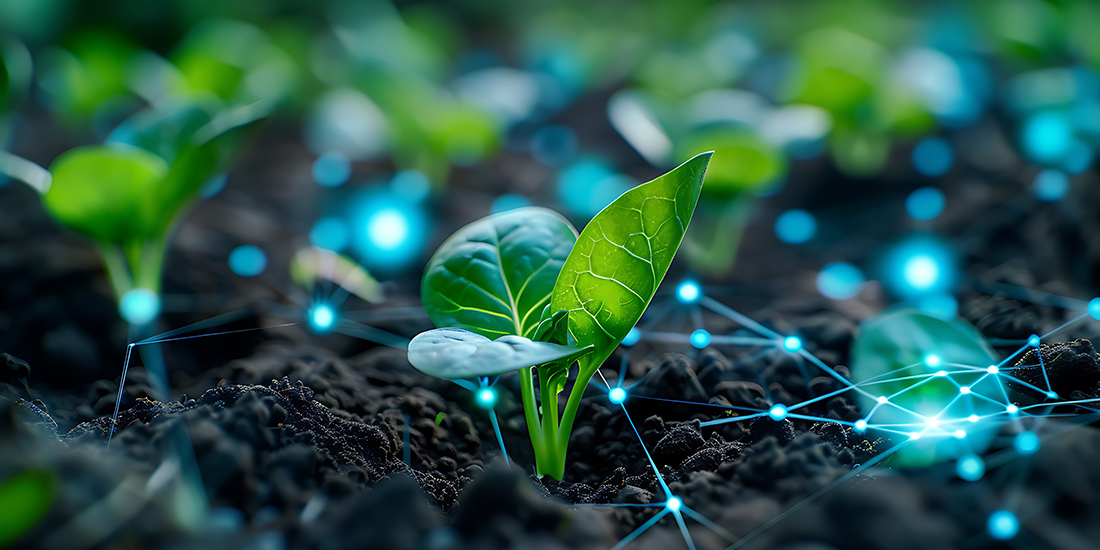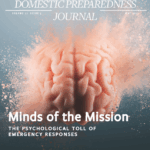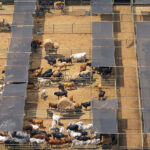The United Nations’ Food and Agriculture Organization projects that the global population will reach nearly 10 billion by 2050. Although estimates vary across academia, such population growth is expected to result in an approximately 50% increase in global food demand. As economies grow and dietary preferences change, food security is of increasing concern.
Food security is defined as the state in which everyone, at all times, has reliable physical, social, and economic access to sufficient, safe, and nutritious food. Food security achieved by policies and mechanisms at the state, national, and international levels ensure that food is protected from intentional adulteration or tampering (food defense) and accidental contamination (food safety) by biological, chemical, or physical contaminants in the post-harvest processing environment, all of which pose risks to public health and economic stability.
Food systems are inherently complex and sustained by global trade networks of inputs and outputs that support agriculture production and food consumption. However, food safety and defense (as an implementation of food security) address only half the supply chain—from post-harvest to consumption—when using the traditional farm-to-table model.
In the cultivation, rearing, and pre-harvest environment, food security can best be achieved by protecting necessary inputs (e.g., seeds, feed, water, energy, fertilizers, pesticides, reproductive resources, and veterinary medicine) used for the primary production of food from crops, livestock, forestry, fisheries, and aquaculture resources. The protection of these inputs from threats, hazards, and vulnerabilities—similar to those in post-harvest and production environments, along with many unique risks—is a key aspect of agricultural security. Additionally, preparedness activities associated with these risks, as well as the enabling of agricultural production, further contribute to the overall concept of agricultural security. Put more simply, agriculture security is the safeguarding of crops, livestock, and associated input supply chains against natural, intentional, or accidental disruption.
Agriculture Under Threat: The Modern Risk Landscape
Agricultural security ensures the protection of essential inputs used in food production, including crops, livestock, forestry, fisheries, and aquaculture. Global agriculture employs 1.23 billion people and spans production, processing, packaging, transportation, and distribution. The U.S. food and agriculture sector comprises nearly 2 million farms, over 700,000 restaurants, and 220,000 food-related facilities, contributing 5.6% to the gross domestic product (GDP) and employs more than 10% of the workforce. Safeguarding these elements and the sector as critical infrastructure is crucial to maintaining food security across the four dimensions of availability, accessibility, utilization, and stability.
Agricultural security encompasses a range of risks—including hazards (e.g., extreme weather events), threats (e.g., agroterrorism, cyberattacks), and vulnerabilities (e.g., reliance on fragile supply chains)—that directly influence food security outcomes. Understanding these distinctions is essential for developing effective mitigation strategies. These risks fall into three broad categories: natural, biological, and technological, each posing significant challenges to food production, distribution, and producer livelihoods. Compounding these challenges are external pressures such as economic instability, geopolitical conflicts, and regulatory shifts, highlighting the need for a comprehensive, adaptive approach to safeguarding agricultural systems.
Extreme Weather and Natural Disasters
Agriculture is among the most exposed and vulnerable sectors to extreme weather and natural disaster given its reliance on natural resources and environmental conditions. Such disasters have resulted in an estimated $3.8 trillion in global losses across crop and livestock production, or 5% of global agricultural GDP.
Extreme temperatures, drought, floods, storms, and wildfires can devastate crops and livestock, disrupt supply chains, and threaten rural economies. Following are examples of how such events may impact agricultural security.
- Extreme Heat & Drought—Prolonged heat and drought conditions can reduce soil moisture, hinder plant growth, lower crop yields, stress and kill livestock, decrease pasture availability, and increase the risk of pest outbreaks.
- Floods—Excessive rainfall and flooding can erode soil, waterlog crops, spread plant diseases, disrupt planting and harvesting schedules, damage infrastructure, and contaminate water and food supplies.
- Storms—High winds and heavy rain from hurricanes, cyclones, and severe thunderstorms can physically damage crops, uproot trees, and destroy greenhouses, barns, irrigation systems, and other agricultural infrastructure.
- Wildfires—Fires destroy crops, scorch grazing lands, kill livestock, and damage agricultural infrastructure, while indirectly impairing plant respiration, growth, and subsequent yield.
Pests, Pathogens, and Disease
Animal and plant diseases threaten agricultural systems. Outbreaks of livestock diseases like foot-and-mouth disease, African swine fever, or avian influenza can have catastrophic economic and social consequences. Similarly, crop diseases such as wheat rust or citrus greening threaten food supplies.
Following are examples of how pests, pathogens, and disease may impact agricultural production.
- Crop Losses—Plant diseases and pests destroy crops, reducing yields and affecting food availability.
- Livestock Mortality—Disease outbreaks in livestock production lead to a variety of impacts, which could include mass culling, reduced domestic herd populations, severe economic losses, supply chain disruptions, and food shortages.
- Trade Disruptions—Plant and animal disease outbreaks not only result in site quarantines and other movement restrictions, but also disrupt international trade and agricultural market continuity.
- Soil & Ecosystem Damage—Pathogens may persist in soil, reducing long-term land productivity and resulting in costly plant disease management and control operations.
Invasive Species
Invasive species disrupt ecosystems and agricultural productivity. Competition against native species damage crops, dispersing novel pathogens. The economic impact of invasive species has escalated from $2 billion annually in North America in the 1960s to over $20 billion yearly since 2010. Globally, the cost has exceeded $1.2 trillion over the past five decades.
Below are a few examples of how invasive species may impact agricultural production.
- Crop Damage—Invasive pests and pathogens consume and infect crops, spreading diseases and reducing harvest quality and quantity.
- Soil & Water Disruption—Invasive plants out-compete native vegetation, deplete soil nutrients, alter root structures, and alter water availability.
- Livestock Impacts—Toxic invasive plants reduce grazing land quality, while invasive pests and wildlife may contribute to disease spread, negatively impacting livestock health.
- Increased Costs—Invasive pests and pathogens may compel producers to allocate resources to disease or pest management, control efforts, and enhanced biosecurity measures, which all increase operational expenses.
Technological
The integration of digital technologies in agriculture has improved efficiency but has also introduced vulnerabilities that threaten crop and livestock production. Cyberattacks on automated and smart farming systems, IoT-connected devices, and cloud-based data platforms can disrupt agricultural production, leading to economic losses and food security risks. Malicious actors, including agroterrorists, cybercriminals, and other malicious actors, may exploit these vulnerabilities to manipulate critical agricultural processes, causing large-scale disruptions.
Below are examples of the risks associated with agricultural reliance on technology and potential impacts to agricultural security.
- IoT Device Disruptions—Hacking IoT sensors and devices can alter data on soils, weather conditions, and livestock health, leading to incorrect irrigation, fertilization, and health interventions, potentially causing crop failures and livestock health issues.
- Automated Machinery Disruptions—Cyberattacks on automated machinery and robotics such as drones, autonomous tractors, and robotic harvesters can disrupt planting, spraying, and harvesting operations, resulting in operational delays, crop damage, and reduced
- Cloud-Based Data Platform Disruptions—Breaches in cloud-based data platforms can lead to unauthorized access and manipulation of agricultural data, compromising decision-making processes and exposing sensitive information, which can result in financial losses and competitive disadvantages.
- Artificial Intelligence and Machine Learning Disruptions—Manipulated AI algorithms and machine learning models can result in incorrect forecasting and recommendations for crop management, which may lead to poor crop health, reduced yields, and increased vulnerability to pests and diseases.
- Supply Chain Management Disruptions—Cyberattacks on supply chain management systems can delay the delivery of essential inputs like seeds, feed, and fertilizers, disrupting crop planting and livestock feeding practices, which leads to lower yields, compromised animal health, and financial losses.
- Wireless Sensor Network (WSN) Disruptions—Attacks on WSNs can lead to data tampering and denial of service attacks, compromising the accuracy and availability of environmental monitoring data, which is critical for precision agriculture.
Agriculture’s security challenges extend beyond environmental and biological hazards, encompassing intentional sabotage or compromise of agricultural systems by malicious actors, geopolitical instability, market volatility, labor shortages, and resource competition. These broader pressures exacerbate existing vulnerabilities. Weak data integration and fragmented oversight and awareness hinder threat detection. Trade disruptions and workforce shortages further weaken the capacity of a food system to absorb, adapt to, and recover from disruptions while maintaining stable access to sufficient, safe, and nutritious food for all. Biosecurity threats like agroterrorism and food fraud compromise supply chain integrity, and land conversion—the transformation of agricultural land for urban, industrial, or other non-agricultural uses—alters ecosystems in ways that facilitate the spread of pests and disease. Water scarcity also increases that susceptibility, weakens natural pest control mechanisms, and diminishes overall agricultural productivity. These evolving threats, hazards, and vulnerabilities continue to reshape the agricultural landscape, amplifying risks to global food production and distribution.
Meeting the Challenge: A Systems Approach to Agriculture Security
The multifaceted threats and challenges to agricultural security necessitate a systems-based approach, recognizing the interconnected nature of food production, trade, biosecurity, and the interdependencies with other critical infrastructure (e.g., water, transportation, chemical, and energy). A systems-based approach in pre-harvest and production environments is a holistic framework that integrates biological, environmental, and operational factors to enhance both security and resilience in agricultural systems in order to withstand, adapt to, and recover from disruptions. At the same time, agricultural systems can maintain productivity and long-term stability. This approach moves beyond linear problem-solving to account for complex interactions between inputs, production practices, external threats and hazards, and the broader regulatory and economic landscape. Unlike isolated interventions that focus on individual hazards, a comprehensive framework requires coordinated efforts across stakeholders, including emergency management and other government agencies (e.g., public health, agriculture, environment) agencies, producers, veterinarians, scientists, and global trade partners—each operating within unique regulatory and operational frameworks, making harmonization a significant challenge. A systems-based approach must address unpredictable factors like pests, pathogens, regulations, geopolitics, and market volatility, all of which can disrupt security countermeasures. For example, while biosecurity is critical to preventing and controlling livestock disease, outbreaks will always be a risk that can disrupt supply chains, weaken consumer confidence, and destabilize markets. Even small vulnerabilities in any of these areas can create cascading effects that compromise both agricultural and food security.
Below are some examples of how a systems-based approach may strengthen agricultural security efforts.
- Interjurisdictional Coordination—Agricultural emergencies often involve multiple agencies within a state, leading to fragmented communication, lack of coordination, and possible response delays. A systems-based approach fosters coordinated policies, integrated surveillance, and unified emergency planning, ensuring seamless collaboration across state departments, local governments, and industry stakeholders for rapid risk mitigation and hazard control.
- Interconnected Risk and Cascading Impact—Traditional agricultural risk management often focuses on isolated threats and hazards (e.g., a specific livestock disease or natural disaster). However, food and agriculture emergencies are multifaceted, interconnected, and create cascading failures across supply chains, affecting production, processing, trade, and consumer access. A systems-based approach ensures cross-sector collaboration and adaptive risk mitigation to prevent single-point vulnerabilities from escalating into broader crises.
- Integrated Biosecurity—Whether driven by emerging pathogens, invasive pests, or environmental disruptions, biosecurity challenges in crop and livestock systems transcend farm boundaries and production systems. Integrated surveillance, cross-sector disease management, and coordinated mitigation strategies are essential to prevent transmission pathways, protect agricultural assets, and strengthen food systems.
Agricultural security is fundamental to global food security, yet it faces an evolving array of risks—from extreme weather and biological hazards to cyber vulnerabilities. Addressing these challenges requires a systems-based approach that recognizes the interconnectivity of food production, supply chains, and technological infrastructure. Traditional linear models of food security are insufficient. Agricultural security efforts must integrate measures across pre- and post-harvest environments to incorporate advanced biosecurity, long-term agroecosystem security strategies, and robust cybersecurity frameworks.
However, implementing such a comprehensive approach is not without challenges. The costs of integrating advanced security measures—such as enhanced awareness, secure digital infrastructure, and comprehensive biosecurity planning—can be prohibitive, particularly for small-scale producers. Additionally, systemic coordination among diverse stakeholders requires overcoming regulatory, logistic, and financial barriers. Together, stakeholders can develop adaptive, forward-thinking solutions that safeguard agricultural systems against disruptions by fostering collaboration among emergency managers, veterinarians, producers, and other relevant preparedness partners.
Despite these challenges, the long-term benefits of agricultural security—ensuring food supply stability, minimizing economic losses, and reducing crisis response expenditures—underscore the necessity of proactive investment in resilience measures. In an increasingly complex and uncertain world, securing the foundations of food production demands a comprehensive, systems-driven approach—one that ensures the stability, safety, and sustainability of global food supplies for future generations.
The views expressed in this article are solely those of the authors and do not represent the views or positions of their respective institutions.
Additional contributions to this article were made by Marshal Wilson (co-director, Southwest Border Food Protection and Emergency Preparedness Center at New Mexico State University).

Joshua Dise
Joshua Dise is an interdisciplinary national security and emergency management professional with experience in both operational and analytical roles. His work addresses complex and interconnected risks, including industrial hazards, transboundary diseases, cybersecurity, and systemic threats to critical infrastructure. He currently serves as a systems analyst at Sandia National Laboratories, where he provides decision support on ill-defined, multi-domain national security challenges using a broad range of technical skills and expertise. Prior to this, he served as a lead technical analyst and emergency planner at Sandia, where he was responsible for delivering a variety of hazard analyses and consequence assessment products. His research interests include environmental hazard response, biosecurity, agricultural and public health preparedness, natural resource management and security, and the convergence of digital and physical infrastructure risks. Joshua holds advanced degrees in emergency management and natural resources and is currently a Ph.D. student at Oklahoma State University, studying fire and emergency management administration. He is also an alumnus of the National Preparedness and Leadership Initiative at Harvard University.
- Joshua Disehttps://domprep.com/author/joshua-dise
- Joshua Disehttps://domprep.com/author/joshua-dise
- Joshua Disehttps://domprep.com/author/joshua-dise
- Joshua Disehttps://domprep.com/author/joshua-dise

Adrian Self
Adrian Self is an Operations Research Analyst at Kansas State University’s National Agricultural Biosecurity Center, where he manages advanced technological research and development across multiple program areas. Self’s industry and academic background is diverse, encompassing economics research, investment analysis, risk underwriting, and hazard uncertainty calculus. He also possesses knowledge in technology, communications, and foreign languages and cultures, further enhancing multidisciplinary approaches to research and development. His prior roles in regulatory and research compliance complement his service as chair of the Kansas State Environmental Health & Safety campus institutional committee. Engaging as a practitioner visionary at intersections of cyber-biosecurity, health security, and food and agriculture enterprise pathway resilience, he explores complex problems as a multidisciplinary strategist.
- Adrian Selfhttps://domprep.com/author/adrian-self






